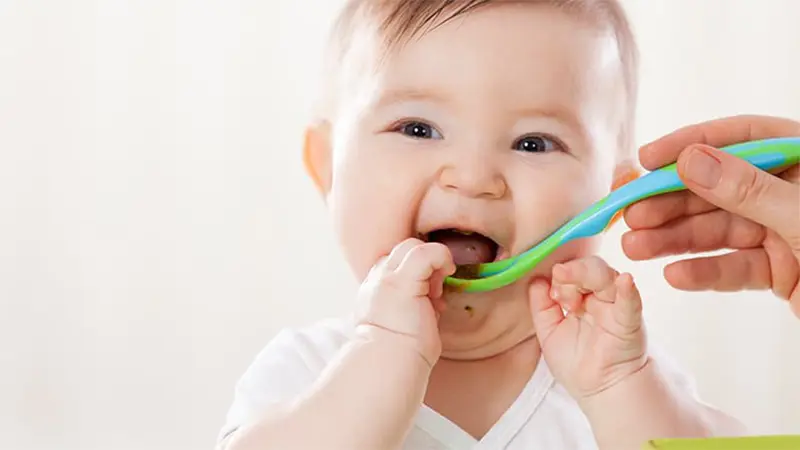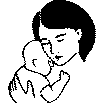When Can Babies Start Eating Baby Food? This is a topic that many parents find themselves wondering about. When can babies start consuming baby food?

There are differing opinions on the topic, which largely depend on your child’s age, motor skills, and maturity as a baby.
Starting your baby on solid foods is an exciting milestone but can also be daunting for new parents. When is the right time to start? What types of foods should you introduce first? How do you know if your baby is ready?
In this blog post, we’ll answer all these questions and more to help you confidently navigate the transition from milk to solids. Let’s get started!
Signs that Baby is Ready for Solid Foods:
Many signs tell your child is ready to move on to solid foods. When your baby is prepared (or its time), you should typically start with some of the following:
1. Motor skills development:
When your baby can sit up straight without the support and hold their head up on their own, it’s a good indication that they are ready to start eating solid foods. This is because they need good authority and neck control to swallow correctly.
2. Appropriate age:
If your baby is on track with their developmental milestones and generally mature, it will typically be ready to start with solid foods at around 9-12 months old.
However, if they are ahead or behind because of illness, they may be given delayed weaning into solids.
3. Food fussiness:
Babies that are fussy or have a lot of fussiness may also have a sore mouth or gums and thus cannot handle adult food well. Introducing rice cereal, bread or toast, and soft puréed fruits or vegetables can often resolve this.
4. Loss of tongue-thrust reflex:
This is a normal part of the development and can be tested by placing a piece of food in your child’s mouth. In some babies, the tongue will thrust to push the food out of their mouth; in others, it may not move.
If the tongue has no movement, there is nothing for the teeth to chew on, and the baby will spit out their food.
5. Swallowing difficulties:
A baby that has difficulty swallowing typically will reject certain foods. They may spit the food or vomit it instead of swallowing it.
This can be tested by introducing some of the foods mentioned above and then pairing those foods with other ingredients you know your child will generally accept.
For example, if your child is fussy with bananas, you can pair them with applesauce to see if they start to eat the apple sauce instead.
6. Increased Hunger:
If your baby seems hungrier than usual, even after a feeding, it may be a sign that they are ready for more solid foods besides breastmilk or formula.
It’s important to remember that every baby develops at their own pace so some babies may be ready for solid foods earlier than others. Talk to your pediatrician for guidance if you’re unsure whether your baby is ready.
Recommended Age to Start Baby on Solid Foods:
When can babies start eating baby food? This will vary with each child, but the recommended age to start solids for most babies is around 6 months old.
However, some babies may be ready as early as 4 months old or as late as 10 months old. Ultimately, it is up to you and your child’s doctor to decide when your baby is ready. Observing your child’s behavior and development will determine whether they are ready.
Types of Baby Food to Introduce First:
Introducing solid foods to your baby is an exciting time, but deciding what types of foods to offer can also be overwhelming. Here are some recommended types of baby food to introduce first:
1. Single-Grain Cereals:
Iron-fortified rice, oatmeal, or barley cereal are often recommended as the first solid food for babies. They are easy to digest and provide important nutrients such as iron and zinc.
2. Pureed Fruits and Vegetables:
Once your baby is comfortable with cereals, you can introduce pureed fruits and vegetables. Start with one type of fruit or vegetable to monitor for allergic reactions or intolerances.
3. Meats and Protein-Rich Foods:
Around 8-10 months old, you can introduce pureed meats and other protein-rich foods such as pureed beans or tofu. These foods provide essential nutrients for growth and development.
4. Baby Food in Bricks, Pouches, and Other Forms:
Finally, you can offer your baby food in bricks, pouches, or other convenient forms. At around 10 months old, babies will often enjoy picking up food with their fingers and putting it in their mouth, so this is a good time to introduce food in a fun way!
It’s important to offer a variety of textures and flavors to your baby to encourage them to develop healthy eating habits.
Once your baby has mastered purees, you can introduce mashed or soft finger foods. Always supervise your baby while they are eating to prevent choking.
How to Introduce Baby Food to Your Baby?
You can introduce baby food to your baby by gradually introducing new foods, starting with single-grain cereals, pureed fruits and vegetables, and then protein-rich foods.
Offer small amounts of food initially and gradually increase as your baby becomes comfortable with new textures and flavors.
Use appropriate utensils and feeding techniques, and always supervise your baby while eating to prevent choking.
So, When Can Babies Start Eating Baby Food?
Babies can start eating baby food between four to six months of age. However, it’s important to note that every baby is different and may be ready at slightly different times.
Several signs can indicate that your baby is ready for solid foods, including:
- Showing an interest in food when you eat around them
- Vocalizing around food as you’re feeding it to them or not eating it
- Grunting, humming, or making sounds around food
- Squirming while feeding, usually when they are chewing on the food
- Drooling while eating or after eating
- Being able to sit up and hold their head steady
- Having lost the tongue-thrust reflex (pushing food out of their mouth with their tongue)
- Showing signs of being hungry even after being breastfed or bottle-fed
Note that some of these signs may mean your baby is only interested in the taste of the food and not the actual nutrition. This is a normal part of the development and does not necessarily mean your baby is ready for solid foods.
What Baby Food Should You Start With?
There are many different types of foods to choose from when you’re feeding a baby food. These include:
- PUREES: These are prepared from steamed or boiled vegetables and fruits, including sweet potatoes, carrots, apples, and pears. These are normally blended with a bit of milk to make them more liquid than solid foods. A famous brand is Easi-Smooth Baby Food.
- SOLIDS: These are prepared from mashed vegetables and fruits, including apples, pears, carrots, potatoes, and sweet potatoes. You can add protein-rich foods, such as tofu, to the mixture.
- FINGER FOODS: These are small pieces of soft food that babies can hold in their hand and feed themselves and include Goldfish crackers, toast, rice cakes, crackers with cheese or yogurt on top, and string cheese bites.
- POUCHES: These are small resealable plastic containers in which you can pack various foods for your baby to eat independently or feed themselves.
Are Baby Foods Nutritious Enough?
One of the biggest questions parents have is whether or not they should feed their children baby food.
Baby foods tend to be expensive, and many parents are concerned about whether the food they give their children is nutritious enough/ If they want their children to consume as many healthy fruits and vegetables as possible.
You should give them fresh foods rather than baby foods. Baby foods tend to provide little in the way of nutritional value. The purpose of baby food is not so much nutritional value but rather to teach babies how to manage solid foods.
Conclusions:
It’s important to supervise your baby while they are eating to prevent choking. Babies fed baby food tend to be picky and may later reject foods as adults.
It’s also important to ensure your child knows how to eat solid foods safely by introducing them at a young age. Babies should eat tiny amounts of food at a time and should not be given too many foods, including dairy products or other foods that can trigger allergies.
I hope this article has provided valuable information about introducing baby food to babies, including the various nutrients necessary for growth and development.
If you still have questions or concerns, talk to your doctor or a dietician who can help you optimize your child’s diet. Thanks for reading!

Pingback: Can A 1 Year Old Have Crisps? Exploring the Safety
Pingback: Baby Food Chart by Age: A Simple Guide for New Parents - Baby Care Corner